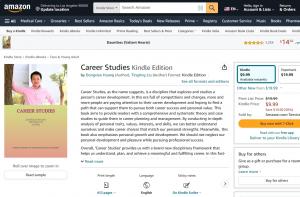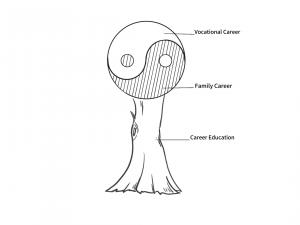
Founder of Career Studies Professor Huang Dongxian: Career Tai Chi Theory and Career Integration Theory
"Career Studies" is the work of Professor Huang Dongxian and Associate Professor Liu Tingting, in which the core theories of career studies are proposed.
MANILA, PHILIPPINES, January 20, 2024 /EINPresswire.com/ -- "Career Studies" is an academic monograph jointly completed by Professor Huang Dongxian and Associate Professor Liu Tingting. It is a pioneering work in the field of career studies, an important discipline related to individual development and growth. This book proposes the theory of Career Tai Chi and the theory of Career Integration, as the founding theories of career studies, laying the foundation for the development of career studies into an independent discipline. (https://www.amazon.com/dp/B0CMK1386R)1. Career Tai Chi Theory: The Harmonious Unity of Family and Vocation.
(1) Tai Chi in Career: The Integration of Family and Vocation
In traditional concepts, what we refer to as "career" emphasizes more on the individual's role in career development, while in Eastern culture, the family always occupies a central position. The Tai Chi diagram of black and white, with the fusion of yin and yang, perfectly showcases the harmonious coexistence of family and vocation.
Family and vocation are like the yin and yang in Tai Chi, both opposing and interdependent, without any distinction between importance or priority. They both play irreplaceable roles in their respective fields. Family provides emotional support and a foundation for life, while vocation is the stage for realizing one's own value.
(2) The Fundamentals of Family Career and the Ascension of Vocation Career
If life is compared to a small grass, then the family is its root, rooted in the soil, providing nutrients for the grass; A profession is like a blade of grass, growing strong and spreading its wings upwards. The black part in the Tai Chi diagram represents family life, located at the bottom, firmly supporting the white part above, which is vocation.
Family is the starting point and also a safe haven. Under the protection of the family, individuals learn to interact with others, acquire life skills, and establish their own values. These are the cornerstones for individuals to enter the workplace and become professionals.
(3) Different definitions of career
For many people, career means work, promotion, salary, and a sense of achievement, but in the theory of career Tai Chi, there is a broader perspective.
For example, for a full-time housewife, she has not entered the formal workplace. In traditional beliefs, she is only a part of the "family", but in the theory of career Tai Chi, her family and career have completely integrated. Taking care of household chores, taking care of children, managing family budgets... all of these are her professions. Her role in the family is not fundamentally different from that of employees and managers in the company.
In the theory of career Tai Chi, career is not just about office work, but also encompasses the efforts made by individuals to achieve certain goals and meet certain needs.
2. Career Integration Theory: also known as Career Tree Theory, showcases the relationship between vocational career, family career, and career education through the image of a tree.
(1) Career Tai Chi Diagram and Career Integration Theory
The Tai Chi diagram of career is used to depict the balance between career and family life. In the Tai Chi diagram of career, career and family are like two sides of yin and yang, both opposing and unified, influencing each other. But the limitation of the career Tai Chi diagram is that it does not include the third important element - career education.
This is precisely the reason for the emergence of career integration theory. It not only focuses on career and family, but also incorporates school education. In this new model, vocational career comes from a social perspective, family career comes from a family perspective, and career education comes from a school perspective. The three dimensions of society, family, and school are integrated and coordinated with each other.
(2) Showcasing the relationship between the three using the image of a tree
The career integration theory uses the image of a tree to demonstrate the relationship between vocational career, family career, and career education. Vocational career and family career are like the crown of a big tree, while career education is like the trunk of a tree.
1) Crown: Vocational career and family career
Vocational career and family career are two important aspects of life. Vocational career provides economic foundation and social identity, while family career provides emotional support and personal growth. They are like the crown of a big tree, blending and developing in the image of a Tai Chi diagram.
2) Tree trunk: Career education
As the main body of a large tree, the trunk provides stability and nutrition for the entire tree, just like career education provides individuals with basic knowledge, skills, and values, determining the heights that can be achieved in their vocational career and family career. Without a solid trunk, the tree crown cannot grow vigorously.
3) Integration: Achievements and values of career
When the trunk is solid and upright enough, the crown will be full and full, symbolizing that an individual has reached a certain level of harmony and achievement in their vocation and family.
(3) Practice of career integration
To achieve career integration, it is necessary to establish a mechanism of mutual support and resource sharing at the three levels of society, family, and school.
1) Social level: The government and enterprises need to provide more career development opportunities and training, as well as more flexible working hours and locations, so that people can better balance vocation and family.
2) Family level: Family members need to support each other and participate in family decision-making together to achieve harmony between family and vocation.
3) School level: Schools need to provide comprehensive career education, including career planning, interpersonal relationships, and personal growth, to cultivate students' comprehensive abilities.
(Huang Dongxian is a professor at Hubei University of Economics and Management, honorary dean of Zhongnuo Career Education Research Institute, and a doctoral student in education at National University.)
Huang Dongxian
National University
email us here
EIN Presswire does not exercise editorial control over third-party content provided, uploaded, published, or distributed by users of EIN Presswire. We are a distributor, not a publisher, of 3rd party content. Such content may contain the views, opinions, statements, offers, and other material of the respective users, suppliers, participants, or authors.




